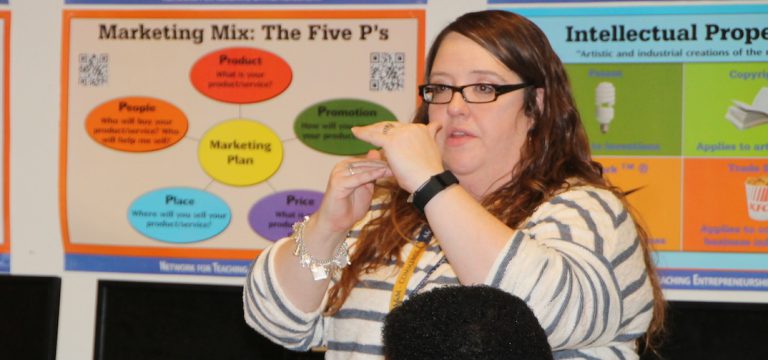Think back to your eighth-grade business, marketing and finance class.
Well, that might be a bit difficult for some because, chances are, you didn’t have one. However, as school districts today develop more rigorous, engaging and relevant curriculums, middle school students like those in Dee Coyle’s eighth-grade business/marketing/finance class this past school year learned how to run a business.
With words like entrepreneur, disposal value and depreciation being the center of class discussions, “it’s kind of like teaching a foreign language,” Coyle jokes.
Coyle is a Career and Technical Education (CTE) teacher at Harold Wendell Lang Sr. Middle School. In her class, students are required to develop an idea for the kind of business they will start and then spend the year learning the ins and outs of running that business.
“They have to write a full business plan and do a presentation,” she said. “They also have to learn to make decisions that will impact their business.”
In addition, students must create their own advertising to market their business. During the school year, student ads adorn the wall outside Coyle’s classroom, promoting a variety of businesses. From baby and dog sitting services to designer shoe laces and recycled cell phone cases, the business ideas run the gamut.
During a visit during the past school year, students discussed fixed versus variable expenses as they explored the economics of one unit of sale and calculated percentages to determine how to market and price their product or service.
“They’re doing math, and they’re not griping about it, because in here, math is money for their business,” Coyle said. “So it’s that real world application, where they see the ‘why’ of learning math.”
Other core subjects like English are woven into the Network for Teaching Entrepreneurship curriculum as Coyle insists on the business plans being well written with correct grammar, sentence structure and spelling.
The journey from the beginning of the class to the end of the year can be quite revealing and a great lesson no matter the outcome.
“Some students have actually taken their plans and started real businesses, and then there are some who know for sure that this is not what they want to do,” Coyle said.
CTE programs are gaining momentum throughout the country as educators seek to engage students and equip them with 21st century tools to help them become career- and college-ready.
The benefit is tremendous, as students prepare for high-wage, high-demand career fields as early as middle school. According to the latest numbers from TEA, students enrolled in two or more CTE classes outperform students who don’t participate in these specialized career courses. The graduation rate and standardized scores are higher for these students, and their dropout rate is lower than students who do not take CTE courses.

